
Smart city basics
First, we will organize the definition and basic concept of a smart city.
What is a smart city? ?
Smart cities use new technologies such as ICT to cross-organizationally and cross-sectorally utilize the diverse data that exist in our lives, create new value such as sophistication of social services, and solve various problems. Cities and regions that enrich people's lives by
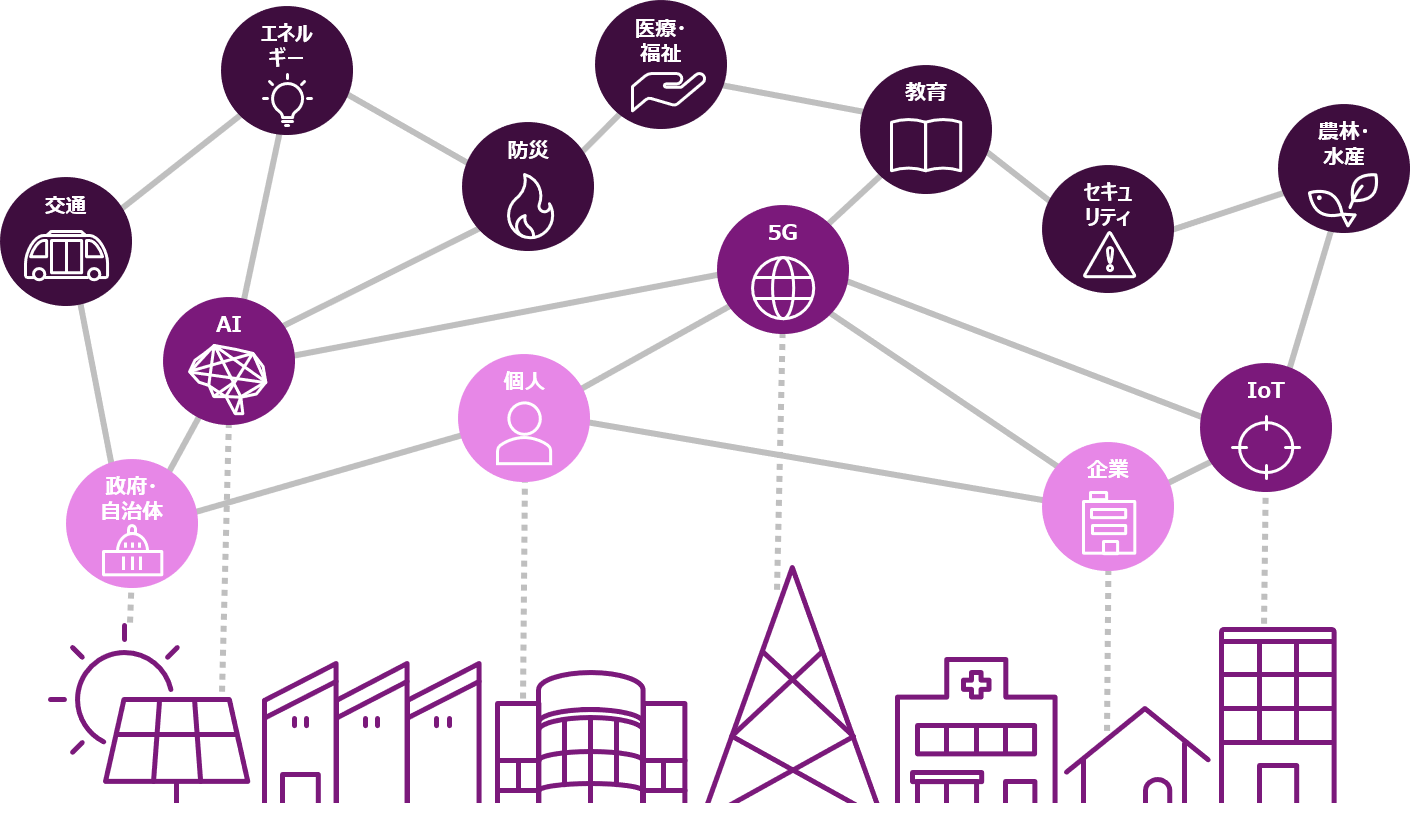
Smart city overview
For example, in the medical field, long waiting times for patients to visit hospitals is an issue. Therefore, IoT devices are installed on trains, buses, etc., which are the means of transportation when going to the hospital, and the patient's interview data is measured in advance by vital sensing while moving. In addition, location information such as trains and buses that transport patients will be shared with the hospital in real time. By analyzing this information (data) with AI and accurately predicting patient arrival times and examination times, we can expect to streamline hospital operations and eliminate patient waiting times.
In this way, smart cities do not deal with issues in each area individually, but instead seek to solve issues through overall optimization in which multiple areas interlock. By utilizing various data with new technologies such as IoT and AI, we aim to create new functions that are useful to society and improve the quality of people's lives.
Basic Concept of Smart City
In the guidelines presented by the Cabinet Office, the following four basic concepts are considered important in promoting smart cities. In particular, "City Management" and "City OS" are regarded as the most important elements as the two wheels of smart city realization.
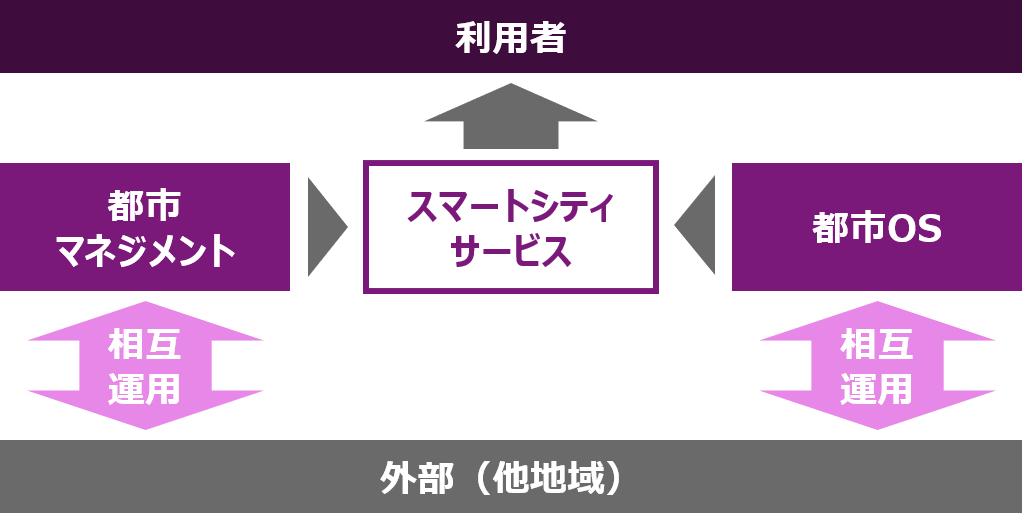
Basic Concept of Smart City
(1) User-centered principle
“All parties involved in smart cities need to always be aware of the users of smart city servicesand promote smart city initiatives.”
The essential purpose of smart cities is to enable service users such as local residents, tourists, and local businesses to live and work more conveniently and comfortably. Therefore, all those involved in smart cities need to proceed with their efforts based on the user-centric principle.
(2) Role of city management
“In order for smart cities to continue to operate sustainably, it is necessary to have the ability to manage the entire region.“
In the promotion of smart cities, efforts with a sense of unity are required, such as information sharing and cooperation among related parties, design of business models for smart cities as a whole, etc., in order to advance development efficiently. To that end, it is necessary to implement a smart city promotion organization as a city management function that manages the entire region from a bird's-eye view.
(3) Role of City OS
“By providing smart city services through City OS, data and services“
City OS is a platform that enables the free distribution and utilization of services and data in various regions and fields. It creates new social services and efficiently laterally deploys the results of each region. can. In smart cities, it is necessary to cross-link services and data inside and outside the region through city OS.
④Importance of interoperability
“In order to efficiently promote smart city development throughout Japan, it isnecessary to efficiently interoperate with other regions and other systems.”
In order to efficiently realize smart cities throughout Japan, it is necessary to deploy specific services horizontally and utilize them in multiple regions. To that end, it is necessary to be aware of and promote the functions of system interoperability by City OS and human interoperability by City Management.
Reference: Smart City Reference Architecture (Cabinet Office)
Mechanism for realizing a smart city
In order to realize a smart city, it is essential to utilize data across organizations and fields inside and outside the region. Therefore, a mechanism for freely distributing data and expanding social services is required.
From individual optimization to overall optimization
Conventional services use only the data that exists in each organization and field, such as government and business, transportation and energy, and are operated as individually optimized services specialized for each. This is because the specifications of the data handled by each organization and field are not standardized, making it impossible to distribute and utilize data across organizations and fields. Therefore, it is necessary to incorporate a "city OS (data linkage platform)" with the function of standardizing different types of data into the regional structure. As a result, it will be possible to combine different types of data across organizations and fields to create new services that are optimized for the whole.
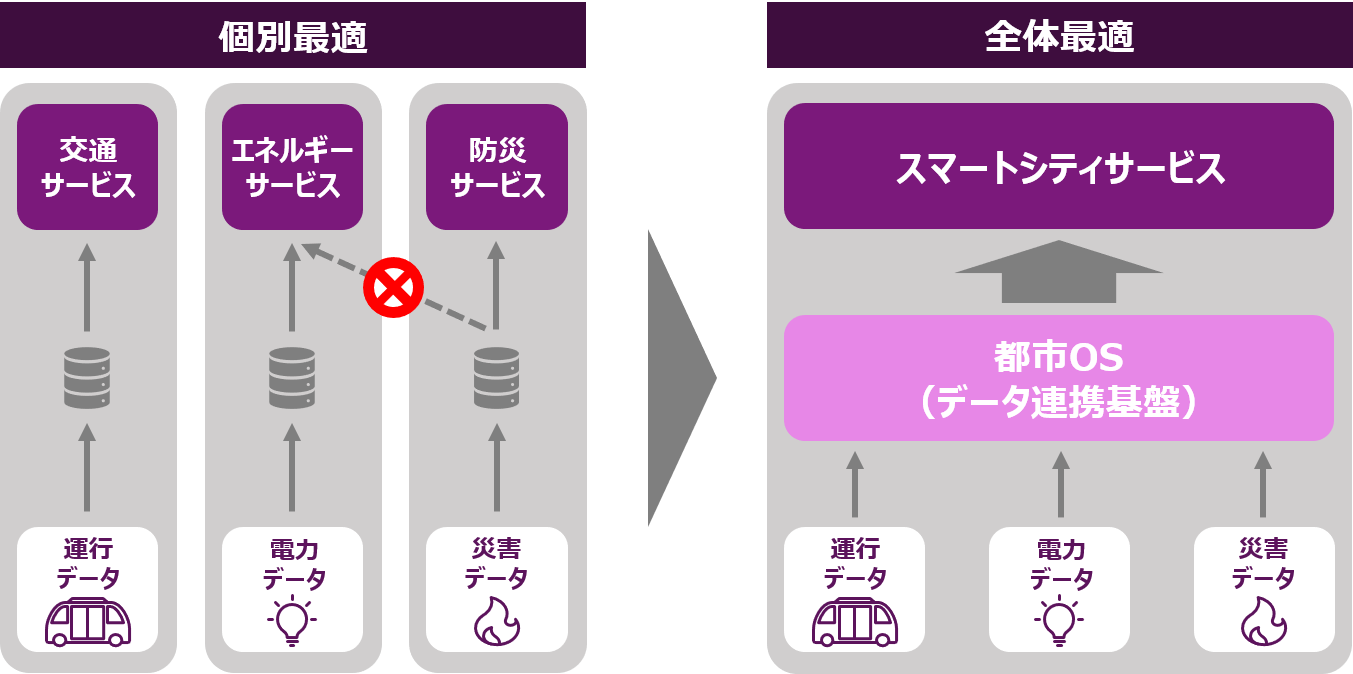
Individual optimization type and overall optimization type
Ideal smart city platform
In smart cities, various data assets required by local governments, companies, and individuals are distributed to city OS via open APIs. And by standardizing various data with different specifications through City OS, it will be possible to link data. Furthermore, we will create new value by utilizing AI analysis and visualization of this data across organizations and fields. By building such a system as a regional platform, we can expect to expand social services and solve regional issues.
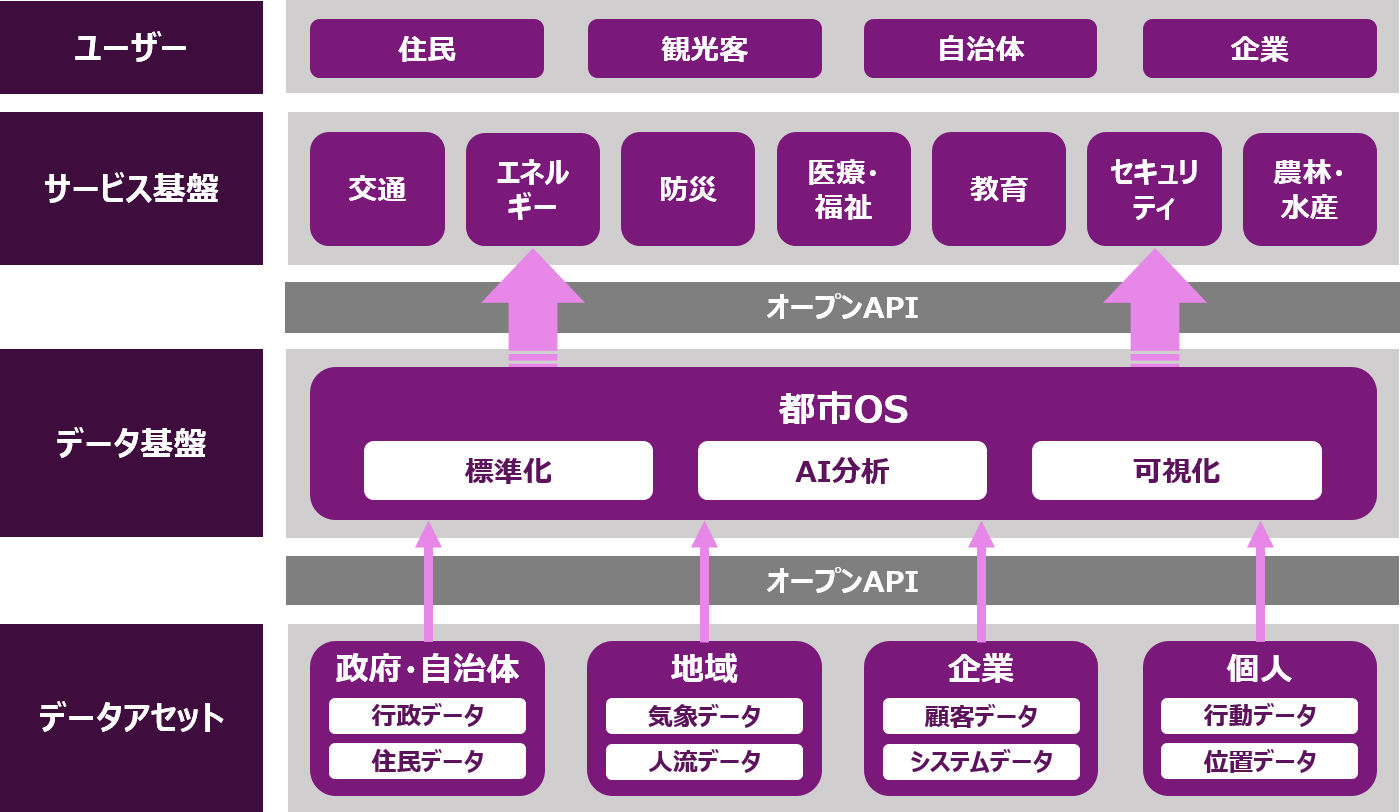
Ideal smart city platform
Roles required of City OS
It is said that there are three challenges in realizing a smart city. City OS is designed with features that address these issues, and plays an important role in the realization of smart cities.
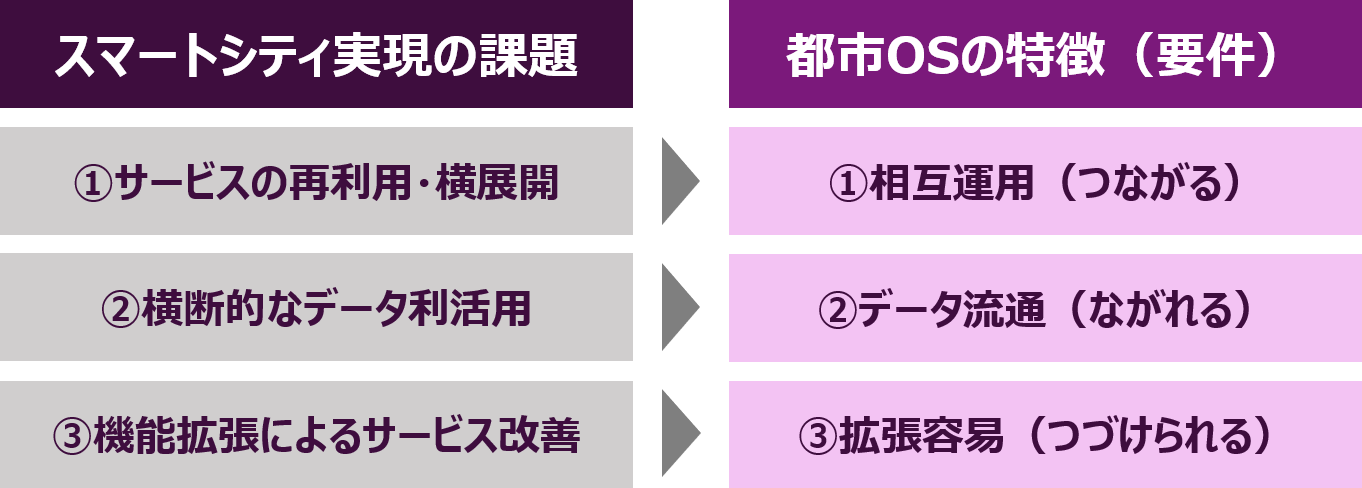
Challenges of Smart City and Characteristics of City OS
Challenges in realizing a smart city
(1) Services cannot be reused or expanded horizontally
With conventional services, systems are individually specialized for each region's organization and field, making it difficult to roll out and reuse in other regions.
(2) Cross-sectional data utilization is not possible
Various data that exist in society are independent as unique data for specific purposes, making it difficult to utilize data across organizations and fields.
(3) Service cannot be improved by expanding functions
An individualized system increases the cost and effort required to expand functions, makes it impossible to continuously update the system, and makes it difficult to improve services.
Features (requirements) of City OS
(1) Interoperability (connection)
In order to enable service collaboration inside and outside the region and horizontal development of results in each region, it is necessary to have common functions and standard interfaces and publish them to the outside.
(2) Data circulation
It will be necessary to standardize and mediate heterogeneous data so that various data within and outside the region can be freely distributed across fields and organizations.
(3) Easy to expand (can be continued)
In order to respond to changes in regional needs and policies, and to sustainably maintain and develop, it is necessary to be able to easily expand and update functions.
Reference: Smart City Reference Architecture (Cabinet Office)
Solutions for smart cities
Introducing Macnica 's solutions for smart cities.
Expolis Cloud Platform
A small-start urban OS that accelerates regional data distribution
The Expolis Cloud Platform is a city OS (data linkage platform) that allows you to start regional "data distribution" from a small start. When local governments consider local population visions and measures, solutions and corporate information that are sufficient in urban areas are not distributed to local governments for reasons such as economic rationality, and there is no shared environment among local governments. There is a problem that it is not possible to grasp the best practices of other local governments. By utilizing the Expolis Cloud Platform, it is possible to reduce the time and human costs from the formulation of measures for regional issues to their introduction, so that local governments can start DX at low cost without having to bear the high introduction costs, and achieve sustainable development. We aim to contribute to the realization of local communities and solve local issues.
MaaS support service
Total support for the practical application of smart mobility
MaaS support services support the commercialization of services that utilize smart mobility such as autonomous driving vehicles. We provide total support, from proposals for optimal vehicle and system configurations to meet customer requirements, prior verification such as demonstration experiments, implementation work for autonomous driving, maintenance in operation, and maximization of introduction effects. We will design the optimal service model for various use cases and realize the utilization of smart mobility.
LiDAR recognition algorithm development support service
Total support from LiDAR data collection to object recognition software construction
Our LiDAR recognition algorithm development support service provides total support from collecting LiDAR data to building object recognition software. We provide the optimal system for recognizing objects such as cars, pedestrians, and bicycles from point clouds according to customer requirements. Additionally, the output information can be flexibly adjusted depending on the use case, such as detecting intrusion into a specific area or counting the number of pedestrians. This reduces the man-hours, time, and costs required for customer system development and supports early market introduction.
Satellite data utilization support service
Supporting solving regional issues using satellite data
The satellite data utilization support service utilizes data from satellites equipped with radars called SAR (Synthetic Apeture Radar) to observe ground deformation, understand damage in the event of a disaster, and monitor conditions on the ground, such as monitoring the state of forests. By observing in real time, we support the solution of various regional issues.
Inquiry
If you have any questions about smart cities, please feel free to contact us here.
